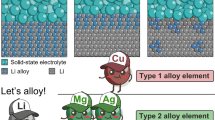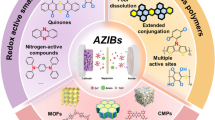Abstract
The interplay between solid electrolytes and electrodes is of vital importance to the performance of all-solid-state Li batteries. Recently, halide superionic conductors have emerged as a new family of high-performance solid electrolytes, but their compatibility with Li metal, i.e., the anode with the highest theoretical capacity, has not been systematically studied. Here, we investigate the interaction between Li metal and two representative halide solid electrolytes: Li3YCl6 and Li3YBr6. Both materials are found to form interphases with Li, similar to most solid electrolytes. However, the interphases observed here contain electronic conducting components, which are detrimental to their compatibility with Li. By elucidating this phenomenon, the present study provides guiding principles for improving the Li compatibility of halide solid electrolytes.

摘要
固态电解质与电极之间的相互作用对全固态锂电池的性能至关重要. 最近, 研究者发现了一类新的高性能固态电解质: 卤化物超离子导体. 但是, 它们与锂金属这一理论比容量最高的负极的相容性尚未被系统研究. 本文中, 我们研究了锂金属和两种代表性卤化物固态电解质—Li3YCl6和Li3YBr6—之间的相互作用. 这两种材料和其他很多固态电解质类似, 与锂发生反应形成中间相. 然而, 此处观察到的中间相包含电子导电成分, 会损害固态电解质对金属锂的相容性. 通过解析这一现象, 本工作为改善金属锂和卤化物固态电解质的相容性提供了指导法则.
Similar content being viewed by others
References
Goodenough JB, Park KS. The Li-ion rechargeable battery: a perspective. J Am Chem Soc, 2013, 135: 1167–1176
Janek J, Zeier WG. A solid future for battery development. Nat Energy, 2016, 1: 16141
Famprikis T, Canepa P, Dawson JA, et al. Fundamentals of inorganic solid-state electrolytes for batteries. Nat Mater, 2019, 18: 1278–1291
Manthiram A, Yu X, Wang S. Lithium battery chemistries enabled by solid-state electrolytes. Nat Rev Mater, 2017, 2: 105–126
Li X, Liang J, Yang X, et al. Progress and perspectives on halide lithium conductors for all-solid-state lithium batteries. Energy Environ Sci, 2020, 13: 1429–1461
Zhou L, Kwok CY, Shyamsunder A, et al. A new halospinel superionic conductor for high-voltage all solid state lithium batteries. Energy Environ Sci, 2020, 13: 2056–2063
Li X, Liang J, Luo J, et al. Air-stable Li3InCl6 electrolyte with high voltage compatibility for all-solid-state batteries. Energy Environ Sci, 2019, 12: 2665–2671
Asano T, Sakai A, Ouchi S, et al. Solid halide electrolytes with high lithium-ion conductivity for application in 4 V class bulk-type all-solid-state batteries. Adv Mater, 2018, 30: 1803075
Li X, Liang J, Chen N, et al. Water-mediated synthesis of a superionic halide solid electrolyte. Angew Chem Int Ed, 2019, 58: 16427–16432
Li X, Liang J, Adair KR, et al. Origin of superionic Li3Y1−xInxCl6 halide solid electrolytes with high humidity tolerance. Nano Lett, 2020, 20: 4384–4392
Tomita Y, Matsushita H, Kobayashi K, et al. Substitution effect of ionic conductivity in lithium ion conductor, Li3InBr6−xCLx. Solid State Ion, 2008, 179: 867–870
Liang J, Li X, Wang S, et al. Site-occupation-tuned superionic LixScCl3+x halide solid electrolytes for all-solid-state batteries. J Am Chem Soc, 2020, 142: 7012–7022
Muy S, Voss J, Schlem R, et al. High-throughput screening of solid-state Li-ion conductors using lattice-dynamics descriptors. iScience, 2019, 16: 270–282
Park KH, Kaup K, Assoud A, et al. High-voltage superionic halide solid electrolytes for all-solid-state Li-Ion batteries. ACS Energy Lett, 2020, 5: 533–539
Schlem R, Muy S, Prinz N, et al. Mechanochemical synthesis: A tool to tune cation site disorder and ionic transport properties of Li3MCl6 (M = Y, Er) superionic conductors. Adv Energy Mater, 2019, 10: 1903719
Xu W, Wang J, Ding F, et al. Lithium metal anodes for rechargeable batteries. Energy Environ Sci, 2014, 7: 513–537
Kim H, Jeong G, Kim YU, et al. Metallic anodes for next generation secondary batteries. Chem Soc Rev, 2013, 42: 9011–9034
Yu C, Li Y, Adair KR, et al. Tuning ionic conductivity and electrode compatibility of Li3YBr6 for high-performance all solid-state Li batteries. Nano Energy, 2020, 77: 105097
Wang S, Bai Q, Nolan AM, et al. Lithium chlorides and bromides as promising solid-state chemistries for fast ion conductors with good electrochemical stability. Angew Chem Int Ed, 2019, 58: 8039–8043
Zhu Y, Mo Y. Materials design principles for air-stable lithium/sodium solid electrolytes. Angew Chem Int Ed, 2020, 59: 17472–17476
Lewis JA, Cortes FJQ, Boebinger MG, et al. Interphase morphology between a solid-state electrolyte and lithium controls cell failure. ACS Energy Lett, 2019, 4: 591–599
Zhu J, Zhao J, Xiang Y, et al. Chemomechanical failure mechanism study in NASICON-type Li1.3Al0.3Ti1.7(PO4)3 solid-state lithium batteries. Chem Mater, 2020, 32: 4998–5008
Hartmann P, Leichtweiss T, Busche MR, et al. Degradation of NASICON-type materials in contact with lithium metal: formation of mixed conducting interphases (MCI) on solid electrolytes J Phys Chem C, 2013, 117: 21064–21074
Chen R, Li Q, Yu X, et al. Approaching practically accessible solidstate batteries: stability issues related to solid electrolytes and interfaces Chem Rev, 2020, 120: 6820–6877
Zhu Y, He X, Mo Y. First principles study on electrochemical and chemical stability of solid electrolyte-electrode interfaces in all-solid-state Li-ion batteries. J Mater Chem A, 2016, 4: 3253–3266
Murugan R, Thangadurai V, Weppner W. Fast lithium ion conduction in garnet-type Li7La3Zr2O12. Angew Chem Int Ed, 2007, 46: 7778–7781
Han F, Gao T, Zhu Y, et al. A battery made from a single material. Adv Mater, 2015, 27: 3473–3483
Chen C. Ionic conductivity, lithium insertion and extraction of lanthanum lithium titanate. Solid State Ion, 2001, 144: 51–57
Schwöbel A, Hausbrand R, Jaegermann W. Interface reactions between LiPON and lithium studied by in-situ X-ray photoemission. Solid State Ion, 2015, 273: 51–54
Tippens J, Miers JC, Afshar A, et al. Visualizing chemomechanical degradation of a solid-state battery electrolyte. ACS Energy Lett, 2019, 4: 1475–1483
Zhu Y, He X, Mo Y. Origin of outstanding stability in the lithium solid electrolyte materials: insights from thermodynamic analyses based on first-principles calculations. ACS Appl Mater Interfaces, 2015, 7: 23685–23693
Wenzel S, Sedlmaier SJ, Dietrich C, et al. Interfacial reactivity and interphase growth of argyrodite solid electrolytes at lithium metal electrodes. Solid State Ion, 2018, 318: 102–112
Lü X, Wu G, Howard JW, et al. Li-rich anti-perovskite Li3OCl films with enhanced ionic conductivity. Chem Commun, 2014, 50: 11520–11522
Kim S, Oguchi H, Toyama N, et al. A complex hydride lithium superionic conductor for high-energy-density all-solid-state lithium metal batteries. Nat Commun, 2019, 10: 1081
Feng X, Chien PH, Patel S, et al. Synthesis and characterizations of highly conductive and stable electrolyte Li10P3S12I. Energy Storage Mater, 2019, 22: 397–401
Acknowledgements
This research was supported by the National Key R&D Program of China (2018YFA0209600 and 2017YFA0208300), the National Natural Science Foundation of China (51802302), and the Fundamental Research Funds for the Central Universities (WK3430000006)
Author information
Authors and Affiliations
Contributions
Fu Y conducted the experiments and wrote the manuscript. Ma C provided the overall concept and supervised the research.
Corresponding author
Additional information
Conflict of interest
The authors declare that they have no conflicts of interest.
Yuanyuan Fu received her Bachelor’s degree from Nanjing University of Science and Technology in 2018 and is currently studying for her Master’s degree at the University of Science and Technology of China (USTC). Her main research interests focus on all-solid-state batteries and halide solid state electrolytes.
Cheng Ma received his BS degree of materials science and engineering in 2006 from Tsinghua University (Beijing, China) and PhD degree of materials science and engineering in 2012 from Iowa State University. After completing his work as a postdoctoral researcher at the Oak Ridge National Laboratory in 2016, he joined USTC as a professor. His research interest lies in the critical materials and interfaces in all-solid-state Li batteries.
Rights and permissions
About this article
Cite this article
Fu, Y., Ma, C. Interplay between Li3YX6 (X = Cl or Br) solid electrolytes and the Li metal anode. Sci. China Mater. 64, 1378–1385 (2021). https://doi.org/10.1007/s40843-020-1580-3
Received:
Accepted:
Published:
Issue Date:
DOI: https://doi.org/10.1007/s40843-020-1580-3




